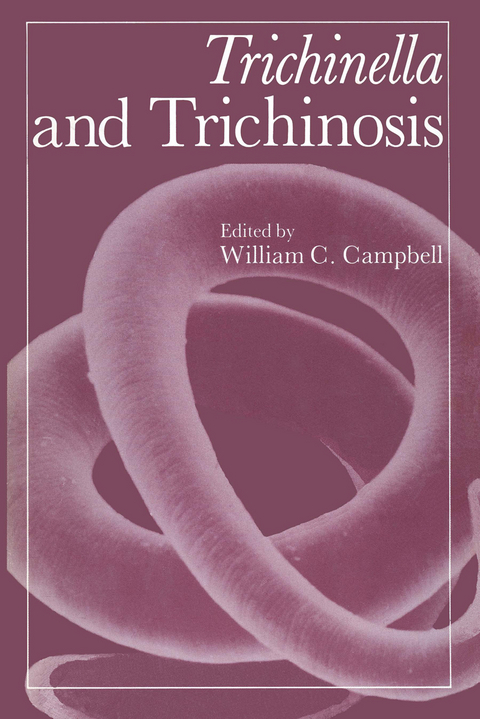
Trichinella and Trichinosis
Springer-Verlag New York Inc.
978-1-4613-3580-1 (ISBN)
1 Historical Introduction.- 1. Prologue: Ghosts of Christmas Past and Christmas Present.- 2. A Worm Discovered (1835).- 3. A Nematode Life Cycle Discovered (1835–1860).- 4. From Zoological Curiosity to Lethal Pathogen (1860–1900).- 5. Consequences (Politics and Parasites).- 6. The Recent Past.- References.- 2 Species, and Infraspecific Variation.- 1. Historical Perspective.- 2. A Working Definition of Species.- 3. Terminology.- 4. Distribution of Isolates.- 5. Criteria for Species and Isolates.- 6. Trichinella spiralis var. pseudospiralis—an Enigma.- 7. Speciation in Trichinella.- 8. Future Considerations.- References.- 3 Biology.- 1. Introduction.- 2. Ingestion of the Infective First-Stage Larva.- 3. Digestion of Host Tissues away from the Infective First-Stage Larva.- 4. Intramulticellular Enterai Niche.- 5. Intracellular Parenteral Niche.- References.- 4 Biochemistry.- 1. Introduction.- 2. Carbohydrates and Carbohydrate Metabolism.- 3. Respiration.- 4. Lipids and Lipid Metabolism.- 5. Nucleic Acids and Nucleic Acid Metabolism: Muscle Larvae.- 6. Proteins and Protein Metabolism: Muscle Larvae and Adult Worms.- 7. Nutrition.- References.- 5 Anatomical Pathology.- 1. Introduction.- 2. Gastrointestinal Tract.- 3. Striated Muscle.- 4. Other Organs Involved.- References.- 6 Pathophysiology of the Gastrointestinal Phase.- 1. Format of This Review.- 2. Gastrointestinal Symptoms.- 3. Morphological Changes.- 4. Physiological Changes.- 5. Bases for Functional Changes.- 6. Host-Parasite Interrelationships.- 7. Relationships between Pathophysiology and Symptoms.- 8. Summary.- References.- 7 Pathophysiology of the Muscle Phase.- 1. Introduction.- 2. Parasite-Induced Modifications in Host Striated Skeletal Muscle.- 3. Cardiopathophysiology in Trichinosis.- References.- 8 TheImmune Response.- 1. Introduction.- 2. Immunity and the Intestinal Phase.- 3. Immunity and Newborn Larvae.- 4. Genetic Influences on Immunity to Trichinella.- 5. Stage Specificity of the Immune Response.- References.- 9 Antigens.- 1. Introduction.- 2. Source of Antigens.- 3. Enumeration, Isolation, and Characterization of Antigens.- 4. Concluding Remarks.- References.- 10 Chemotherapy.- 1. Introduction.- 2. Experimental Chemotherapy.- 3. Clinical Chemotherapy.- References.- 11 Clinical Aspects in Man.- 1. Introduction.- 2. Infection and Disease.- 3. Symptoms, Signs, and Clinical Pathology.- 4. Diagnosis.- 5. Management and Treatment.- References.- 12 Immunodiagnosis in Man.- 1. Introduction.- 2. Immunodiagnostic Methods.- 3. Evaluation and Recommendation.- 4. Conclusions.- 5. Protocols for Indirect Immunofluorescence and Enzyme-Linked Immunosorbent Assay.- References.- 13 Epidemiology I: Modes of Transmission.- 1. Introduction.- 2. Sylvatic Cycle.- 3. Domestic Cycle.- 4. Special Epidemiological Circumstances.- 5. Susceptible Host Species.- References.- 14 Epidemiology II: Geographic Distribution and Prevalence.- 1. Introduction.- 2. North America.- 3. Europe.- 4. Scandinavia.- 5. Eastern Europe.- 6. Union of Soviet Socialist Republics.- 7. Asia.- 8. Africa.- 9. Australia, New Zealand, and Pacific Islands.- References.- 15 Control I: Public-Health Aspects (with Special Reference to the United States).- 1. Introduction.- 2. Mechanisms of Control.- 3. Measures Adopted in the United States.- References.- 16 Control II: Surveillance in Swine and other Animals by Muscle Examination.- 1. Introduction.- 2. Trichinoscopic Method.- 3. Basic Digestion Method.- 4. Pooled Digestion Methods.- 5. Other Direct Diagnostic Methods.- 6. Summary.- References.- 17 Control III: Surveillancein Swine by Immunodiagnostic Methods.- 1. Introduction.- 2. Serological Methods.- 3. Sensitivity and Specificity.- 4. Antigen Preparation and Purification.- 5. Evaluation of Serological Methods in Various Geographic Areas.- 6. Mechanization.- 7. Surveillance by Serological Methods.- 8. Concluding Remarks.- References.- Appendix 1 Synopsis of Morphology.- 1. Introduction.- 2. Morphology of the Adult Male.- 3. Morphology of the Adult Female.- 4. Morphology of the Infective First-Stage Larva.- References.- Appendix 2 Laboratory Techniques.- Methods.- References.
| Zusatzinfo | XXIV, 582 p. |
|---|---|
| Verlagsort | New York, NY |
| Sprache | englisch |
| Maße | 152 x 229 mm |
| Themenwelt | Sachbuch/Ratgeber ► Natur / Technik ► Garten |
| Medizin / Pharmazie ► Medizinische Fachgebiete ► Mikrobiologie / Infektologie / Reisemedizin | |
| Studium ► Querschnittsbereiche ► Infektiologie / Immunologie | |
| Naturwissenschaften ► Biologie ► Mikrobiologie / Immunologie | |
| ISBN-10 | 1-4613-3580-9 / 1461335809 |
| ISBN-13 | 978-1-4613-3580-1 / 9781461335801 |
| Zustand | Neuware |
| Haben Sie eine Frage zum Produkt? |
aus dem Bereich


